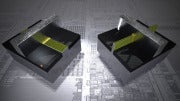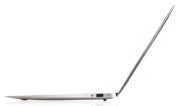Laptops in the refreshed category will start rolling out in time for the 2011 holiday season led by Asus' UX21. The first round of Ultrabooks will be followed by two more waves in 2012 and 2013 sporting new Intel processors. Here's a breakdown of Intel's plans for the kinda-sorta-new laptop category, Ultrabooks.
What's under the hood of an Ultrabook?
Intel has announced three waves of Ultrabooks. The first wave becomes available later in 2011 and will include laptops based on the current crop of Sandy Bridge Core i5 and i7 processors.

3D Transistors, Thunderbolt and USB 3.0
The second wave of Ultrabooks will start hitting in the first half of 2012 and will include Intel's new Ivy Bridge processors based on the Sandy Bridge architecture. The new chips are the first to use Intel's new 22-nanometer (nm) manufacturing technology that can implement 3D transistors on Intel chips. The result is a chip that is 37 percent faster than Intel processors made using the 32-nm manufacturing process, according to the company.
The 3D transistors reportedly consume less than half the power of their 2D counterparts currently used in chip manufacturing. Intel also says chips made with the 22-nm process will be cheaper than current chips. Ivy Bridge chips will also include hardware support for Microsoft ' s DirectX 11 graphics. The company also highlighted USB 3.0 and the new Thunderbolt I/O technology at Computex. It's not clear if the second wave of Ultrabooks will include both peripheral ports, but that's probably a good bet.
Relate: Why Intel's 3D Transistors Matter
The third wave of Ultrabooks will arrive in 2013 rocking third-generation Core processors, code-named Haswell. Intel claims Haswell-powered Ultrabooks will be even thinner with longer battery life and reduced power consumption. Tell Me About The Asus UX21
Tell Me About The Asus UX21So far, the only Ultrabook being touted is Asus' UX21. The new laptop has a unibody design, is just 0.67-inches at its thickest point (the MacBook Air is 0.68 in.), and can support up to a Core i7 processor. The 2.4-pound laptop also has an 11.6-inch display with 1366-by-768 resolution, glass trackpad, mini-HDMI, one USB 2.0 port, and one USB 3.0, according to a number of reports. Asus' demo model at Computex included 4GB of RAM. Asus did not announce pricing.
Has Intel Tried A Similar Strategy Before?
During Computex 2009, Intel was talking up its CULV ( consumer ultra - low voltage ) processors with similar goals. At the time, IDG News said Intel ' s goal with CULV ' s was to power a "new class of ultra-thin laptops that are as light as a netbook but pack bigger screens and stronger computing power."
Source




0 comments:
Post a Comment